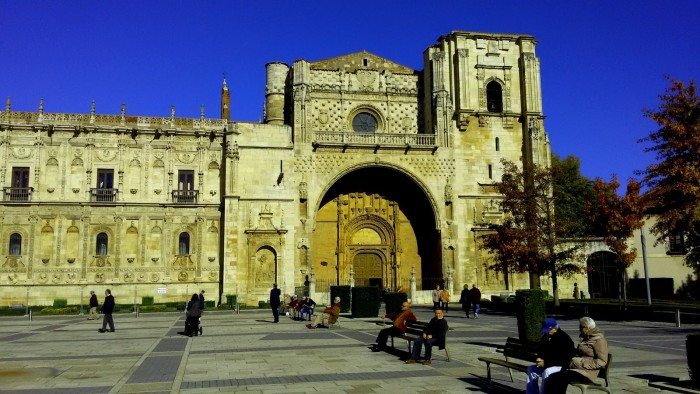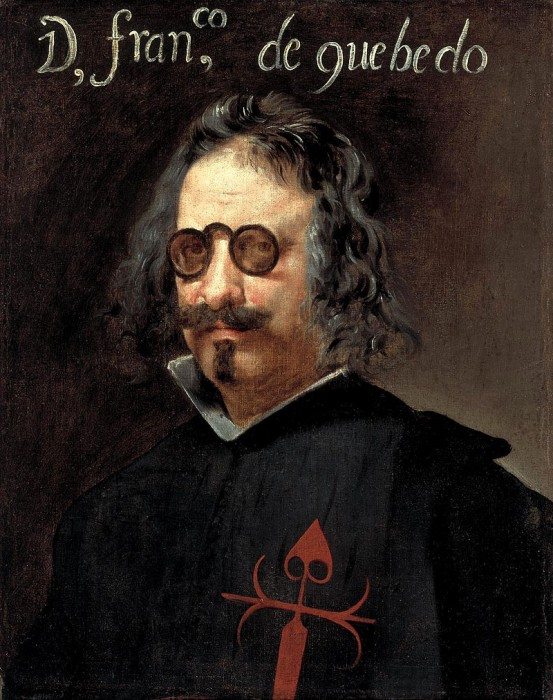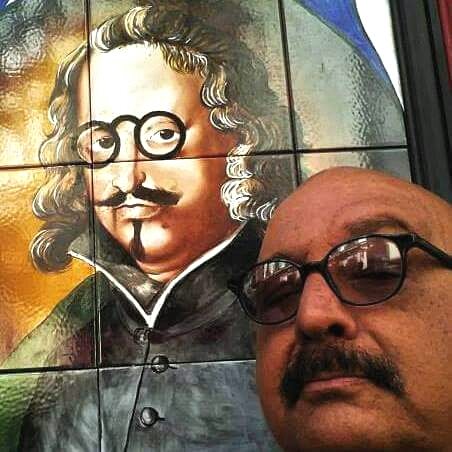Writers are keenly aware that their words, when used without restraint, can create trouble. That’s why most writers censor themselves. It is a key exercise when navigating through troubled waters.
Some writers, however, exhibit little fear of upsetting readers. In fact, dueling by way of the written word seems to be the stimulus they need to fuel their genius.
Francisco de Quevedo was one such writer.
Born in Madrid in 1580, Francisco de Quevedo, along with his archrival Luis de Góngora, are considered the greatest poets of Spain’s Golden Age of literature. Nevertheless, while Góngora, the elder of the two, was a somber person who took his craft seriously, Quevedo, for his entire life, behaved as an enfant terrible. Although he wrote well in every genre, he also produced a vast amount of satirical pieces aimed directly at anyone he considered a rival, such as Góngora, or an inferior, such as the dramatist Juan Ruiz de Alarcón. Because of his propensity toward publicly ridiculing others, even Quevedo’s closest friends remained on guard.
Yet his talent was undeniable. Lope de Vega and Miguel de Cervantes, the two most highly regarded writers of Spain’s Golden Age, befriended Quevedo and praised his intellect. What’s more, because Quevedo was of noble birth, he had received the best education possible. Thanks to his superb intelligence and quick mind, the royal court repeatedly gave him special assignments. With time, to reward his services, Quevedo was made a knight of the Order of Santiago — an organization akin to the Templars but exclusively devoted to defending the Catholic faith as well as pilgrims who traveled along the Camino de Santiago.
Still, Quevedo’s biting wit and his irascible nature kept getting him into trouble. He was exiled from the royal court twice, but was eventually welcomed back. The third time, however, proved disastrous for him.
Because of a note Quevedo wrote against the count of Olivares, he was sentenced to five years in prison. Quevedo invoked his right as a knight to be confined in a monastery of the Order of Santiago. His proposal was accepted on the condition that he remain locked in the dungeon of the San Marcos monastery, located on the outskirts of the city of León.


The convent of San Marcos in León, Spain where Quevedo was imprisoned is today a luxury parador hotel
The Camino passes directly in front of the former monastery, which now houses a museum and the five-star Parador de San Marcos, which appears in the film The Way.
Quevedo spent three years there before being pardoned. While imprisoned, he wrote three studies on theology, a subject dear to him. But by the time of his release, his once indomitable spirit had been broken, and his body was also failing due to the harsh conditions he faced while in the dungeon. He died less than two years later.
The monastery where Quevedo was held prisoner (the dungeon no longer exists) was later used again as a prison — this time as a concentration camp where Francisco Franco held opponents of his regime.
And so it is that one also encounters heartbreaking tales while walking the Camino de Santiago.
***
Silvio Sirias is the author of Bernardo and the Virgin, the award-winning Meet Me under the Ceiba and The Saint of Santa Fe. You can follow him on Twitter @silviosirias.





The Talmud must not be regarded http://utamadomino.com as an ordinary work, composed of twelve volumes; http://utamadomino.com/app/img/peraturan.html it posies absolutely no similarity http://utamadomino.com/app/img/jadwal.html to http://utamadomino.com/app/img/promo.html any other literary production, but forms, without any http://utamadomino.com/app/img/panduan.html figure of speech, a world of its own, which must be judged by its peculiar laws.
The Talmud contains much that http://utamadomino.com/ is frivolous of which it treats with http://dokterpoker.org/app/img/peraturan.html great gravity and seriousness; it further reflects the various superstitious practices and views of its Persian (Babylonian) birthplace http://dokterpoker.org/app/img/jadwal.html which presume the efficacy of http://dokterpoker.org/app/img/promo.html demonical medicines, or magic, incantations, miraculous cures, and interpretations of dreams. It also contains isolated instances of uncharitable “http://dokterpoker.org/app/img/panduan.html judgments and decrees http://dokterpoker.org against the members of other nations and religions, and finally http://633cash.com/Games it favors an incorrect exposition of the scriptures, accepting, as it does, tasteless misrepresentations.http://633cash.com/Games
The Babylonian http://633cash.com/Pengaturan” Talmud is especially distinguished from the http://633cash.com/Daftar Jerusalem or Palestine Talmud by http://633cash.com/Promo the flights of thought, the penetration of http://633cash.com/Deposit mind, the flashes of genius, which rise and vanish again. It was for http://633cash.com/Withdraw this reason that the Babylonian rather http://633cash.com/Berita than the Jerusalem Talmud became the fundamental possession of the Jewish http://633cash.com/Girl Race, its life breath, http://633cash.com/Livescore its very soul, nature and mankind, http://yakuza4d.com/ powers and events, were for the Jewish http://yakuza4d.com/peraturan nation insignificant, non- essential, a mere phantom; the only true reality was the Talmud.” (Professor H. Graetz, History of the Jews).
And finally it came Spain’s turn. http://yakuza4d.com/home Persecution had occurred there on “http://yakuza4d.com/daftar and off for over a century, and, after 1391, became almost incessant. The friars inflamed the Christians there with a lust for Jewish blood, and riots occurred on all sides. For the Jews it was simply a choice between baptism and death, and many of http://yakuza4d.com/cara_main them submitted http://yakuza4d.com/hasil to baptism.
But almost always conversion on thee terms http://yakuza4d.com/buku_mimpi was only outward and http://raksasapoker.com/app/img/peraturan.html false. Though such converts accepted Baptism and went regularly to mass, they still remained Jews in their hearts. They http://raksasapoker.com/app/img/jadwal.html were called Marrano, ‘http://raksasapoker.com/app/img/promo.html Accursed Ones,’ and there http://raksasapoker.com/app/img/panduan.html were perhaps a hundred thousand of them. Often they possessed enormous wealth. Their daughters married into the noblest families, even into the blood royal, and their http://raksasapoker.com/ sons sometimes entered the Church and rose to the highest offices. It is said that even one of the popes was of this Marrano stock.